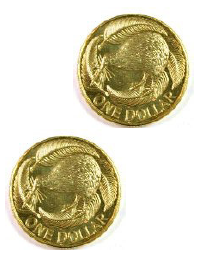This problem solving activity has a number (addition and subtraction) focus.

She exchanges it with her brother Sam for some coins worth $5.Can Mar
Can she exchange it for 6 coins?
What is the largest number of coins that Sam can have given Mary?
- Represent a sum of money by using a combinations of coins.
- Use a list to work systematically.
- Devise and use problem solving strategies to explore situations mathematically (systematic list, use equipment).
In this problem students apply additive strategies to solve money problems. The focus on making a systematic list enables students to check that they have found all possible solutions. To succeed in this problem, students should have had some prior experience with New Zealand currency.
- Play money (notes and coins)
- Copymaster of the problem (English)
- Copymaster of the problem (Māori)
The Problem
Mary has a $5 note. She exchanges it with her brother Sam for some coins worth $5.
Can she exchange it for 6 coins?
What is the largest number of coins that Sam can have given Mary?
Teaching Sequence
- Show students the play money and talk about the images on both sides of the currency,
- Play guess the coin and guess the note. For example:
I have a gold coin with a flying kotuku on it. What coin is it?
I have a red note with Sir Edmund Hillary and a yellow eyed penguin on it. What note is it? - Read the problem to the class. Draw students' attention to the fact that there are two parts to this problem: 1) Can Mary exchange her $5 for 6 coins 2) What is the largest number of coins that Sam can have given Mary?
- Brainstorm ways to solve the problem and have students suggest how they might record their solution ideas in an organised way. Suggest to students that they could make a list or table starting with one value, and then finding all possible outcomes beginning with that value, before starting with a new value.
- As the students work on the problem, ask questions that encourage them to work systematically:
Tell me how you are solving the problem? Why did you select that strategy?
Are there other coins that you could have used?
How do you know that you have checked all the possibilities? - Share solutions.
Extension
Can Mary exchange the $5 for 10 coins? If so, how?
Solution
The coins might have been $2, $2, 50c, 20c, 20c and 10c, or $1, $1, $1, $1, 50c and 50c. But are they all the possible answers? Don't expect the students to give such a complete justification as the one that follows. The answer with a description of how they got it, is fine at this level.
To do this systematically takes a little time. Clearly there can be at most two $2 coins. So suppose that there are precisely two $2 coins. Then we have to make up $1 with four coins. We can’t have two 50c coins but we can have one. Then we have to have at least one 10c coin. Two 20c coins give the only way to finish this case off to give $2, $2, 50c, 20c, 20c, 10c.
What if we only have one $2 coin? Then we can have two, one or no $1 coins. We can’t have two $1 coins because we would have to be able to make up $1 with three coins and this isn’t possible. One $1 coin would mean that we would have to find four coins to make up $2. This can only be done with four 50c coins. So another answer is $2, $1, 50c, 50c, 50c, 50c. So suppose that we have no $1 coins. We have to make up $3 with five coins. But the biggest coin we can have now is 50c and five 50c just isn’t big enough. This means that there is only one answer with one $2 coin.
The most $1 coins we can use is four. This leads to $1, $1, $1, $1, 50c, 50c. If we only use three $1 coins then we have to make up $3 with three coins but 3 x 50 isn’t big enough. The same goes for fewer than three $1 coins.
So there is only one way to use $1 coins (and no $2 coins). There appear to be three answers to the problem.
Part B.
The most coins Sam could have would be when he only had 10c coins. There are fifty tens in 500, and fifty lots of 0.1 in 5. So the largest number of coins that Sam could give to Mary is fifty 10c coins.
Solution to the Extension
This is harder than the 6 coin problem. One approach is to keep a list of the answers that the students give and see how many they can come up with.
Since 10 x 50 = 500, Sam had to have had at least one coin worth 50c or more. So we have to look systematically at the cases where Sam has $2 coins, $1 coins and 50c coins. The only answers are
$2, $2, 20c, 20c, 10c, 10c, 10c, 10c, 10c, 10c;
$2, $1, $1, 20c, 20c, 20c, 10c, 10c, 10c, 10c;
$2, $1, 50c, 50c, 50c, 10c, 10c, 10c, 10c, 10c;
$2, $1, 50c, 50c, 20c, 20c, 20c, 20c, 10c, 10c;
$2, 50c, 50c, 50c, 50c, 20c, 20c, 20c, 20c, 20c;
$1, $1, $1, $1, 50c, 10c, 10c, 10c, 10c, 10c;
$1, $1, $1, $1, 20c, 20c, 20c, 20c, 10c, 10c;
$1, $1, $1, 50c, 50c, 50c, 20c, 10c, 10c, 10c;
$1, $1, $1, 50c, 50c, 20c, 20c, 20c, 20c, 20c;
$1, $1, 50c, 50c, 50c, 50c, 50c, 20c, 20c, 10c;
50c, 50c, 50c, 50c, 50c, 50c, 50c, 50c, 50c, 50c.